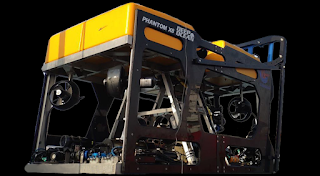Search This Blog
Deep Ocean Engineering provides integrated robotic solutions (ROV & USV) for various underwater applications in diverse operating environments.
Featured
- Get link
- X
- Other Apps
Windfarm Inspection And Monitoring By ROVs
Underwater ROVs have proven to be a great asset in many industries, especially those related to offshore. These underwater ROVs can perform jobs at great depths that aren’t safe for the divers. The efficiency is better, which has made the ROVs to be widely used in offshore industries.
Windfarm
energy generation is one of the industries that seem to have found a great use
for underwater ROVs. Work-class ROVs like Phantom X8 is being used to inspect
and monitor underwater windfarms.
What is a windfarm?
Wind
farms consist of wind turbines and windmills installed in water bodies, mostly
at sea. The concept of wind farms is to generate electricity using the higher
wind speeds in the offshore areas where the turbines are located.
Wind
farm turbines and windmills usually use fixed foundations located in shallow
waters. Hence, wind farms can also be installed in coastal water bodies like lakes
and fjords. Deepwater wind farms are in the phase of development.
How does the underwater windfarm work?
The
windmills and turbines of the wind farms are installed on the river bed or the
ocean floor. The underwater current rotates the blades in the turbines. The
turbines are attached to the gearbox and electrical generator. The electricity
generated as a result is carried to the shore using cables.
Types of offshore wind turbines
Offshore
wind turbines can be classified into two types.
·
Turbines with the anchored foundation: These wind turbines firmly
have foundations on the seafloor. Usually, monopole-type foundations or piles
are used, and the depth of these foundations can reach anywhere between 30m to
60m.
·
Floating turbines: These turbines float on the water, and
they usually consist of three floaters which remain under sea level. This type of
floating turbine helps them work at higher water depths.
Both
types of these underwater wind turbines require regular monitoring and
maintenance.
Advantages of underwater wind farms
Underwater
wind farms are similar to windmills on land, but there are more advantages to
the former.
• The land used to create windmills can be used for other
purposes like housing, agriculture, etc.
•
More electricity is produced since water is denser than air.
•
Predictable outcomes and better efficiency.
ROVs and underwater wind farms
While
there are many advantages to underwater wind farms, one complication was the
ease of monitoring and inspection of these underground structures. This is
where the ROVs come into the picture.
Since
the wind farms are usually located in shallow waters, compact and lightweight
ROVs are adequate for the inspections. These underwater ROVs are being used for
the video inspection and monitoring of windfarm structures and the connection
cables that reach the land.
The
ROVs used for the inspection and monitoring of the underwater windfarms come
with ultra-sensitive cameras and lights, which help their operation in the
turbid waters.
Phantom X8 for windfarm inspection and monitoring
Phantom
X8 is a work class ROV that is designed for deep-sea
maneuverability. It is light in weight and comes with six horizontal and two
vertical thrusters. Even in the most challenging currents, the Phantom X8 operates
accurately.
It
has a rugged and resilient chassis and an aluminum frame that can accommodate
heavier payloads and a variety of sensors. Phantom X8 is adaptable for various
underground tasks other than windfarm inspection like pipeline inspection,
infrastructure repair, etc.
To
learn more about Phantom X8 and its specifications, visit https://www.deepocean.com/rov-phantom-x8.php.
Deep Ocean Engineering
We
have provided quality products and reliable service to our customers for about
30 years. Our products have applications in various industries like scientific
research, offshore oil and gas, nuclear inspection, etc.
- Get link
- X
- Other Apps
Popular Posts
How Underwater ROVs Are Revolutionizing the Oil and Gas Industry
- Get link
- X
- Other Apps


Comments
Post a Comment